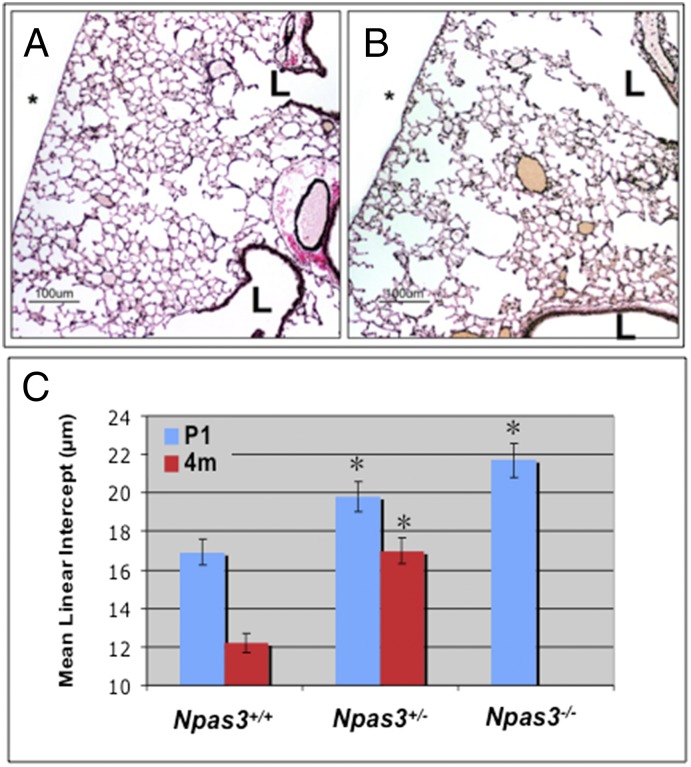MEDICAL SCIENCES
Correction for “NPAS3 is a trachealess homolog critical for lung development and homeostasis,” by Shutang Zhou, Simone Degan, Erin N. Potts, W. Michael Foster, and Mary E. Sunday, which appeared in issue 28, July 14, 2009, of Proc Natl Acad Sci USA (106:11691–11696; first published July 6, 2009; 10.1073/pnas.0902426106).
The authors wish to note, “We have determined that the pulmonary mechanics results given in Fig. 4D cannot be validated in independent experiments. Specifically, we have completed analysis of baseline airway hyper-reactivity (AHR) in new litters of 6–7-month-old NPAS3-deficient (+/−) and wild-type (WT) NPAS3 (+/+) littermate mice, concluding that there is no difference in baseline AHR between WT and NPAS3 (+/−) mice.”
Fig. 4.
Lung histopathology of adult Npas3-deficient mice. (A and B) Lung histopathology from WT (A) and Npas3-Het littermates (B) at 4 months (4 mo) of age (Voerhoff's elastic tissue stain). L, airway lumen; *, pleural surface; bar, 100 μm. (C) Mean linear intercepts of lungs from P1 and 4-mo mice (3 litters each): *P < 0.0001 compared with WT. Note that there were no 4-mo-old Npas3-null mice because pups rarely survived beyond 48 h.
Fig. 4 and the text of the article specific to Fig. 4D have been corrected in the online version. The corrected figure and legend appear below. This correction does not alter the major conclusions of the vast majority of the paper.
The authors also note that the text in the following sections has been changed:
In the Abstract, lines 15–16, “but develop emphysema and airways hyperreactivity” has been corrected to “but develop emphysema.”
In the Abstract, line 19, “may also lead to emphysema and asthma” has been corrected to “may also lead to emphysema.”
On page 11692, right column, third paragraph, lines 5–7, “At 4 mo, Npas3-Hets have significantly increased airway resistance (Fig. 4D), similar to that observed at 6 mo, but not at 3 mo” has been corrected to “At 3, 4, 6, and 7 mo, Npas3-Hets do not have altered baseline airway resistance.”
On page 11694, right column, first full paragraph, lines 7–8, “haploinsufficient adults develop alveolar loss and airways hyperreactivity” has been corrected to “haploinsufficient adults develop alveolar loss.”
On page 11695, left column, second paragraph, line 2, “…leading to abnormal lung development, emphysema, and asthma…” has been corrected to “…leading to abnormal lung development and emphysema…”.
On page 11695, left column, second paragraph, line 4, “Emphysema and asthma are highly prevalent and debilitating chronic lung diseases that are initiated or exacerbated by cigarette smoking or air pollution” has been corrected to “Emphysema is a highly prevalent and debilitating chronic lung disease that is initiated or exacerbated by cigarette smoking or air pollution.”
On page 11695, left column, second paragraph, beginning on line 13, “asthma or COPD” has been corrected to “inflammatory lung diseases.” In the following sentence, “Thus, Npas3-deficient individuals would be at high risk for free radical injury…” has been corrected to “Thus, Npas3-deficient individuals could be at high risk for free radical injury…”.



